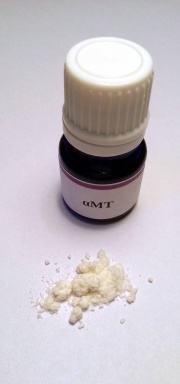 Most research chemicals are seen as new drugs, either completely new syntheses or chemicals which have previously lain dormant in the writings of Alexander Shulgin. However, some research chemicals have a much longer history of use in research, illicit and licit use.
Most research chemicals are seen as new drugs, either completely new syntheses or chemicals which have previously lain dormant in the writings of Alexander Shulgin. However, some research chemicals have a much longer history of use in research, illicit and licit use.
AMT is one of these, having been originally discovered by the pharmaceutical manufacturing company Upjohn while researching novel anti-depressants. It saw particular study due to its properties as a MAOI; eventually, a similar drug (the alpha-ethylated homologue of AMT) was made available as an anti-depressant in the USA during the 60s as ‘Monase.’ Curiously, AMT itself was actually available as the anti-depressant ‘Indopan,’ sold in the Soviet Union between the 60s and the 80s, when it was phased out due to its tendency for interesting side-effects.
Being one of the new psychedelics developed around the 60s, it was included in several studies into the potential psychotherapeutic use of psychedelics along with the likes of psilocybin and LSD. Shulgin himself notes a curious coincidence in the disappearance of a research supply of the chemical, suggesting that recreational use of the drug may have occurred as early as the late 60s – though widespread use did not occur.
Since then, the drug remained in relative obscurity until the 90s, where several online pharmaceutical vendors sold the drug legally with use of the infamous clause ‘not for human consumption’ for as little as $50 a gram. It was available along with several other chemicals such as GHB, and could really be considered the birth of the Internet-borne research chemical movement.
This led to the drug being outlawed in the USA in 2003, though it remained largely legal in most parts of the world. As a result of this failure to ban the chemical worldwide, it has become a mainstay among Web-based research chemical vendors as the movement has grown massively in the first years of the 21st century.
The drug itself receives a wide variation in reports, being a very long-lasting mix between a psychedelic and a stimulant; its visual profile likened very much to LSD while also reported as carrying much more of an empathogenic feel than other psychedelics. Either way, it remains a popular fixture in the research chemical scene.
In 2014, more countries have moved to illegalise the chemical, and it has recently been recommended for scheduling in the UK.
Read more about AMT on our Wiki!

Hi my name is Heather. now 59 years old. 8 years ago I was in a dark place because of the Bizarre death of a friend. 12 months later still feeling bemused and depressed over her death a friend then gave me an AMT pellet and told me that it would help. Well he was right, it healed me of my sadness outright. I met with what could be called God or some vast intelligence that wrapped around me unconditional love and showed me that there was no death. I met psychedelic benevolent beings that showed me a delightful geometric concert when I closed my eyes communicating with me telepathically . These shapes had a great sense of humor and I felt at one with everything. Next few days after the trip I buzzed with Harmony and realized that this is mans natural state but the stress of modern life keeps us from feeling this natural sate. Although AMT is synthetic what it did for me was natural and organic. I thank the spirit of AMT.